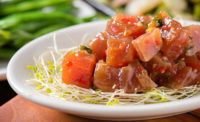Riding the continuous automation wave
Sausage processing continues moving away from islands of automation and towards continuous processing.
By Bryan Salvage, Senior Editor
Everybody loves sausage. And when it comes to what’s “hot” in the sausage category, it is flavorful products that exhibit one significant feature.
“Convenience is a big trend we’re seeing,” Tom Wolff, marketing director for Johnsonville Sausage Inc., Sheboygan, WI, said last summer. “This is evidenced by exponential growth in our smoked and cooked products, which is very rapidly becoming one of our most important product lines.”
The growing popularity and diversification of sausage, however, presents its share of production challenges for processors. Keeping up with demand is among the biggest.
“As sausage processors increase volumes of any one product, they’ll look toward automating this product line,” says sausage-processing expert Bob Rust, president of Rust Associates Inc., Ames, IA, and professor emeritus, Iowa State University.
Sausage processing is becoming more automated because of the need to further reduce costs, the shrinking size of the labor pool, the need to address and improve quality (“quality” meaning repeatable processes and low variation) issues, and the continuing rise in food-safety concerns.
New technology may offer the best solutions to meet these sausage industry challenges.
“There is a movement away from new investment in old technologies,” says Bob Damstetter, vice president, sales, Townsend Engineering Co., Des Moines, IA. “Eliminating labor, unnecessary consumable costs, energy, and improving yield help to reduce product costs,” he adds. “New methods of material handling and final cooking improve food safety. Formulation and new casing materials give improved quality to the final product.”
Investments today are being made in continuous systems that reduce costs, address food safety, and improve the perception of product quality.
Changes afoot
During the past decade, most processors have focused on least-cost formulation, Damstetter says. While this may have been good for the bottom line, the market perception of sausage has been cheapened, he continues.
“This is due to the trend to utilize economy materials and the emergence of a new generation of sausage consumers who aren’t very familiar with truly great sausage products,” he adds. “Thus, the opportunity exists to educate this new generation and introduce them to a higher-quality product at even lower-cost production,” he adds. The fastest-growing categories are composed of products with the highest appearance of quality.”
One leading processor says his company’s commitment to superior product quality is reflected in the processing equipment it buys.
“What drives our equipment decision is whether the end product meets our quality standards,” Earl Beery, senior vice president of food products operation, Bob Evans Farms Inc., Columbus, OH, said last year.
As a result, many technology providers are stepping up to the plate to offer continuous automation equipment and systems. The new handtmann ConPro (Continuous Process) System associates the benefits of the Ruitenberg food-safe VegaCasing with the modularity of handtmann systems. The basic components of this system are two vacuum fillers: a VF 628 for the product to be filled and a VF 620 for the VegaCasing. (See special report on the ConPro in this issue.)
The Townsend QX system offers processors a new way to produce good-looking sausage with great mouthfeel and bite, Damstetter says. Complete line systems make their own casings, and the continuous process can deliver almost any type of sausage: smoked, dry, fresh, and natural-curved sausages.
When Townsend acquired Stork Protecon-Langen in 2001, the world’s foremost coextrusion technologies were united, Damstetter says. Townsend was recognized for Kontura Continuous Casing systems with extended brining technology. Protecon made a name for itself with innovative HiQ tower technology and cook systems. Together, the shared knowledge and proprietary technologies of both companies created the QX system.
“New technologies in the QX system help processors create more exciting and innovative products such as high-snap dinner links, eye-appealing pre-cooked breakfast sausage, and tender-bite ring sausage,” Damstetter says.
Hot dogs, dinner sausage
Hot dogs represent a high-volume segment primarily driven by the skinless or cellulose-casing market, one insider says.
“This has been a continuous processing market for quite a long time, and the benchmark has been the Alkar Inline for many years,” says David Wildes, director of marketing, Alkar, Lodi, WI. “Regarding cellulose casing skinless hot dogs, this system is automated from start to finish. This is where the classic system is a Cozzini or that style of blending and emulsification —all automated. People are not pushing buckets [of sausage] around. Product is pumped directly into a linker, in this case a Townsend NL system, which feeds automatically onto the Alkar processing chain, which automatically goes through cooking and chilling, which automatically unloads, feeds to a peeler, peels the cellulose casings, which automatically feeds into the Drake or Planet collator, and which automatically loads into a RapidPak packaging machine.
“You have people supervising this process, but they are not lifting or handling products throughout the process,” he adds. “We would like them not to touch any product at all, but we’re not quite there yet.”
This benchmark has since shifted to the Alkar J-Con system, Wildes says, which is a good case study of how automation technology keeps moving the market forward.
“You either have to reinvest to stay competitive or you fall behind,” he adds.
The J-Con is an innovation where Townsend’s NL Linker directly connects with the Alkar continuous system, and the linker is looping hot dogs directly on the process chain, which then goes through the J-Con cook-and-chill system. Alkar has further developed this system so a processor can run more than one linker onto the same process chain.
“This is a new development called the High Capacity J-Con, which further establishes it as a highly-efficient, highly-automated system,” Wildes says. “With the J-Con system, there are no meat sticks.”
Regarding dinner sausage, Wildes says there are many natural casing or hog-intestine products in this category. Since hog intestines come in random lengths and variable sizes, processing dinner sausage in natural casings has previously been difficult to automate. The traditional method starts with blending in smaller batches, even bowl choppers if it’s not emulsified. Product is going through traditional stuffers and being filled by hand. People still must participate in filling accurately, linking product into a stick, hanging it onto a meat truck, then pushing the meat truck into a batch oven, pushing it into a chiller, and then taking it off of the stick, cutting it, and packaging it.
“Over the last five years, some large processors with well known national brands have invested in continuous systems to make high volumes of certain dinner-sausage products,” Wildes says. “ These processors have optimized the blending, filling, and hanging steps, but product is still going onto meat sticks.” Alkar has designed special styles of continuous systems to handle natural-casing product. The system can be an Alkar Inline that is specially configured or an Alkar Monorail. Both systems do the continuous cooking and chilling, but then it has to be unloaded, cut, and packaged, and the natural-casing products have still not been automatically collated very well so there is still some manual intervention in that category.
“This represents what you call ‘islands of automation,’ but at least those players have automated some important segments of the process,” Wildes says. “This has given them great efficiency and consistency.”
Over the next three years, expect extrusion technology to further develop, he adds. This extrusion technology automates the entire filling area. This is where Alkar’s interface comes in.
Over the next three years, expect extrusion technology to further develop, he adds. This extrusion technology automates the entire filling area. This is where Alkar’s interface comes in.
“When product exits the extrusion linking phase, we are picking it up with a new continuous system called the WaveCon,” Wildes says. “This new continuous system for smoked sausage-type products does not have any meat sticks. You’re dealing with individual links.”
In this system, product is put into a carrier that serpentines through a cook-and-chill process. Product is then automatically collated into the RapidPak packaging machinery. There are only a few people supervising the entire production line. Benefits include food safety through less handling — and consistency.
“It’s a real challenge to process a consistent product, and that’s why the bigger companies went to continuous process systems,” Wildes says.
As this automation wave further evolves, expect more partnerships between technology suppliers to create continuous processing systems.
“Customers want a total system that works —not a partial solution, which they have to piece together,” Wildes adds.
Investing in technology is a strategy all sausage processors, regardless of their size, must adopt.
“[Continuous automation] is not just for huge companies,” Wildes says. “They may be the first to justify adding technology, but medium or regional processors also need to invest in continuous-automation technology in order to compete because the big companies are coming right into their own back yards.” NP
Technology suppliers participating in this article include:
- Townsend Engineering Co., phone (515) 265-8181 or (800) 247-8609. fax (515) 263-3333, e-mail info@townsendeng.com, or log on to www.TownsendEng.com
- handtmann USA, phone (847)808-1100, fax (847) 808-1106, e-mail info@handtmann.com, or log on to www.handtmann.com
- Alkar, phone (608) 592-3211, fax (608) 592-4039., e-mail marketing@alkar.com., or log on to www.alkar.com



Report Abusive Comment